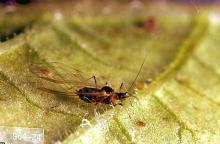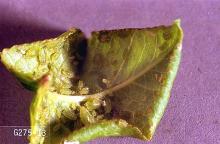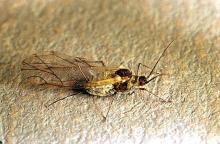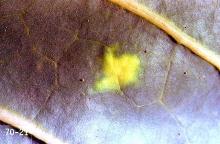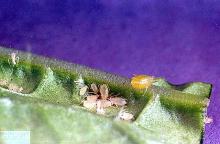Includes
Cabbage aphid (Brevicoryne brassicae)
Green peach aphid (Myzus persicae)
Turnip aphid (Hyadaphis pseudobrassicae)
Pest description, crop damage and life history
See:
Common Pests of Vegetable Crops
Pest monitoring Check fields frequently after seedling emergence. If aphids become numerous, increase frequency of sampling. Aphids often are concentrated in hot spots or near the field margin. Note the presence of any hot spots, but avoid sampling only those areas. Also, be sure to look for evidence of biological control; i.e., the presence of predators, parasitoids (aphid mummies), and pathogens. Aphid flights are most common during periods of moderate temperatures (60° to 80°F). Monitor fields particularly closely during April and May.
Management-biological control
Many parasitoids and predators attack aphids. Early year aphids have many natural enemies that frequently bring them under control later in the year. Among the more common predators are lady beetles and their larvae, lacewing larvae, and syrphid fly larvae. Populations of green peach aphids are reduced in winter by the insect pathogenic fungus Entomophthora aphidis.
Monitor the proportion of aphid mummies relative to unparasitized aphids and the numbers of predators such as lady beetles. If the proportion of mummies is increasing, or predators appear to be gaining control, and aphid populations are not yet damaging, avoid sprays that will disrupt these natural enemies if the crop is not entering a susceptible stage. Most materials available for aphid control are highly disruptive of natural enemy populations.
Management-cultural control
Destroy infested crops immediately after harvest to prevent dispersal. Destroying weed hosts late in the year may help destroy overwintering populations. Roguing diseased plants early may help slow the spread of aphid-vectored diseases. Aphid populations tend to be higher in crops that are fertilized liberally with nitrogen.
Management-cultural control
Aphid populations tend to be higher in plants that are fertilized liberally with nitrogen.
Home gardeners can use row covers or wash aphids from plants with a strong stream of water.
Management-chemical control: HOME USE
Apply to both tops and undersides of leaves.
- azadirachtin (neem extract)-Some formulations are OMRI-listed for organic use.
- bifenthrin (often as a mix wth zeta-cypermethrin).
- capsaicin-Some formulations are OMRI-listed for organic use.
- carbaryl
- cyfluthrin
- deltamethrin
- esfenvalerate
- horticultural oil-Some formulations are OMRI-listed for organic use.
- imidacloprid
- insecticidal soap-May require several applications. Some formulations are OMRI-listed for organic use.
- kaolin-Applied as a spray to foliage, it acts as a repellent to some insect pests. Some formulations are OMRI-listed for organic use.
- malathion
- plant-derived essential oils (rosemary, peppermint, thyme etc.). Some formulations are OMRI-listed for organic use.
- pyrethrins-Some formulations are OMRI-listed for organic use.
- zeta-cypermethrin
Management-chemical control: COMMERCIAL USE
- alpha-cypermethrin (Fastac EC) at 0.02 to 0.025 lb ai/A. PHI 1 day. REI 12 hr. Retreatment interval 4 days. Do not exceed 0.075 lb ai/A per season.
- azadirachtin (Neemix 4.5) at 0.18 to 0.25 lb ai/A. PHI 0 days. REI 4 hr. OMRI-listed for organic use..
- Beauveria bassiana (Mycotrol ESO) at 0.25 to 1 quart/A. PHI 0 days. REI 4 hr. OMRI-listed for organic use.
- beta-cyfluthrin/imidacloprid (Leverage 360) at 0.056 to 0.066 lb ai/A. PHI 7 days. REI 12 hr. Retreatment interval 7 days. Do not exceed 0.022 lb ai/A beta-cyfluthrin or 0.044 lb ai/A imidacloprid per season.
- bifenthrin (Brigade WSB) at 0.08 to 0.1 lb ai/A. PHI 21 days. REI 12 hr. Do not exceed 0.5 lb ai/A per season. Retreatment interval 7 days.
- bifenthrin/zeta-cypermethrin (Hero EW) at 0.04 to 0.1 lb ai/A. PHI 21 days. REI 12 hr. Retreatment interval 21 days. Do not exceed 0.44 lb ai/A per season. Oriental radish (Daikon) only.
- Chenopodium ambrosioides extract (Requiem 25EC) at 4 to 6 pints formulated product per acre. REI 4 hr. Use high rate when conditions are favorable for heavy pressure. OMRI-listed for organic use.
- Chromobacterium subtsugae (Grandevo) at 0.6 to 0.9 lb ai/A per 100 gal. PHI 0 days. REI 4 hr. OMRI-listed for organic use.
- cyfluthrin/imidacloprid (Leverage 2.7) at 0.074 lb ai/A. PHI 7 days. REI 12 hr. Retreatment interval 7 days. Do not exceed 0.03 lb ai/A cyfluthrin or 0.04 lb ai/A imidacloprid per year.
- deltamethrin (Delta Gold) at 0.012 to 0.028 lb ai/A. PHI 3 days. REI 12 hr. Retreatment interval 3 days. Do not exceed 0.14 lb ai/A per season. Washington only.
- flonicamid (Beleaf 50SG) at 0.062 to 0.089 lb ai/A. PHI 3 days. REI 12 hr. Do not exceed 0.267 lb ai/A per season. Limit 3 applications. Retreatment interval 7 days.
- flupyradifurone (Sivanto 200SL) at 0.09 to 0.14 lb ai/A PHI 7 days. REI 4 hr. Retreatment interval 10 days. Do not exceed 0.365 lb ai/A per season.
- imidacloprid (Admire Pro) at 0.16 to 0.38 lb ai/A, or 0.011 to 0.027 lb ai/1,000 row ft. soil; 0.044 lb ai/A foliar . Do not exceed 0.13 lb ai/A foliar or 0.38 lb ai/A per season. PHI 7 days foliar; 21 days soil. REI 12 hr.
- imidacloprid (Provado, Prey) at 0.044 lb ai/A. PHI 7 days. REI 12 hr. One application per season. Do not exceed 0.044 lb ai/A per season.
- insecticidal soap (M-Pede) at 1 to 2% solution. Potassium salts of fatty acids. See label for gal/A rates. PHI 0 days. REI 12 hr.
- malathion (Fyfanon 8) at 1 lb ai/A. PHI 7 days. REI 12 hr. Retreatment interval 7 days. Limit 3 treatments.
- sulfoxaflor (Transform WG) at 0.023 to 0.047 lb ai/A. PHI 7 days. REI 24 hr. Limit 4 treatments. Do not exceed 0.266 lb ai/A per year.
- thiamethoxam (Actara) at 0.023 to 0.047 lb ai/A. PHI 7 days. REI 12 hr. Retreatment interval 7 days. Do not exceed 0.063 lb ai/A per season.
- thiamethoxam (Platinum) at 0.078 to 0.1 lb ai/A soil treatment. REI 12 hr. Retreatment interval 7 days. Do not exceed 0.063 lb ai/A per season.
- zeta-cypermethrin (Mustang) at 0.05 lb ai/A. PHI 7 days. REI 12 hr. Do not exceed 0.3 lb ai/A per season. Retreatment interval 7 days.
These products contain commonly used active ingredients for control of aphid in radish. There are other materials available. Please consult a licensed crop advisor for additional recommendations.

